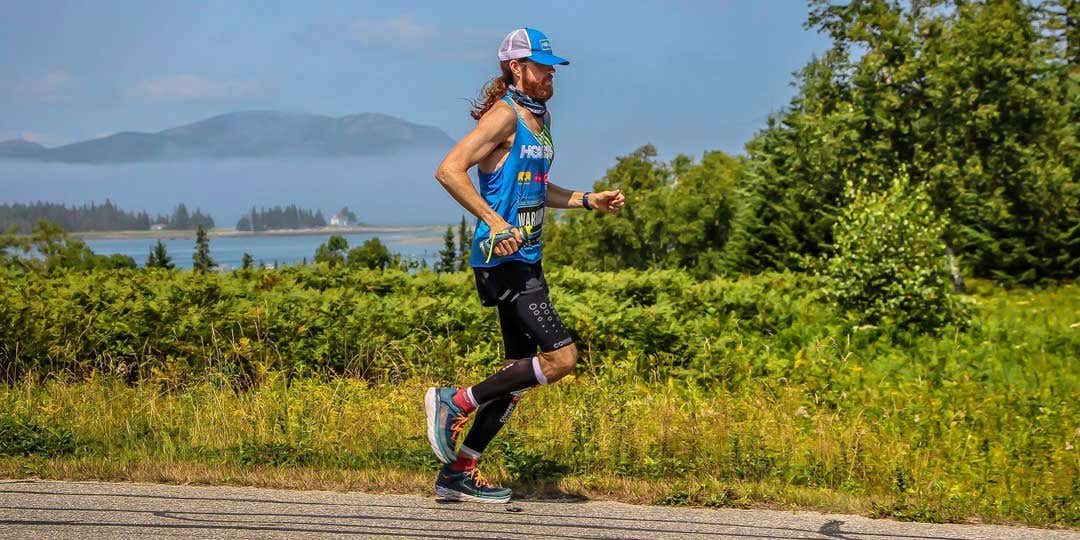Recovering from race day is nothing new to Michael Wardian, the 44-year old ultra runner extraordinaire who’s run races all over the United States and the world. This Injinji athlete is a high achiever in almost all facets of running, from the road to the trail, to niche competitions across the world. Michael actually holds SIX world records! A few of our favorites? The title for fastest marathon as Spider Man & Elvis, fastest 50K on a treadmill and the fastest time for SEVEN marathons on seven different continents in just seven days!
This truly impressive runner is not only highly decorated, but down to Earth and a whole lot of fun to talk to. Michael spent some time with us so we could pick his brain about a few tips for recovering from race day (no matter what race you’re running). Take a peek at what he had to say!
Photo courtesy of: A&B Photography
Listen to Your Body
Simple, right? We know, everyone you’ve ever talked to about recovery has said something along the lines of “listen to your body.” But are we all doing this? Michael told us in 2012 he suffered five stress fractures on his pelvis and five hernias, both characteristically overuse injuries.
He laughed when he told us, “Before I used to say I listened to my body, but I really wasn’t. I may have been listening to it, but I wasn’t accepting what it was telling me.
So the key to listening to your body is really twofold. You have to learn to listen to the signs of trouble, but you also have to take them seriously and act on them.
“Now I feel like I’m a lot better about being cognizant of when something’s odd, and if it is odd, I take care of it. I really am dedicated to being a runner for my entire life,” Michael explained. “I might not always be a sponsored runner, I might not always be winning races, I might not be able to do crazy things like I do now, but I always want to be able to go out and go for a run. When I had the injury and I couldn’t do that, I would have given anything just to go and run around the block.”
Foam Roll, Foam Roll, Then Foam Roll Some More
According to Michael, he’s a foam rolling fanatic. And the nice thing? There are all types of different foam rollers, so you can find one (or a few!) to fit your unique needs.
“I do quite a bit of foam rolling, and I have a lot of different ones. The one I’m really liking right now is a TB12 with a vibrating feature,” Michael explained.
Foam rollers are great, though there are different schools of thought on whether they work better before or after your runs/workouts. At the end of the day it’s about personal preference! Do what works for you, but whatever you do, remember to roll.
Eat to Fuel Your Body
No matter what, the food you choose to fuel your body with is incredibly important. That becomes even more important when you’re an athlete. Watching what goes into your body, where it comes from and how you feel after eating certain foods is key.
“Recovery and eating right is super important. I don’t drink really, I’m vegetarian, pretty regimented about what I’m putting in my body, I’m very aware of the type of fuel I give myself, what it does to me,” said Michael. “If I eat eat oats, how do I feel? If I eat almond butter (one of my favorite things is almond butter), how do I feel? That whole holistic approach to my entire existence is about being able to stay in peak performance and really hone what I have, especially as I age. I want to make sure I do everything I can to continue to be optimally conditioned.”
Stay Pliable, Mobile and Strong
The best defense is a well-planned offense, and by that we mean working out areas that could be problems before they ever get to that point. For runners, a lot of those areas are caused by moving in just one plane of motion. If you only train your body to react in one direction to certain stimuli, when asked to adjust in a different direction, it’s not as strong or ready to react. That’s where cross-training comes in!
Michael started working with a trainer about a year and a half ago, and he says it’s helped his body’s holistic health immensely. “With my trainer, I do monster walks, frankensteins, dead bugs to open your hips, open gaits, exercises for ankle stability and strengthening,” he said. “I’m always trying to stay pliable and mobile and strong, but I have to be careful about how often I do that and at what intensity.”
The first step to staying pliable, mobile and strong is to assess where you’re at. If you’re not confident, try signing up for a movement assessment with a physical therapist or certified trainer, then making some goals and working toward them.
No matter what kind of racing you’re doing, it’s important to have a recovery routine to help your body function at high capacity. It’ll probably take a little bit of testing, practice and maybe a bit of help from the pros, but the most important thing to remember is that it works for you. So get out there and get your recovery on. Happy racing and recovering, athletes!









